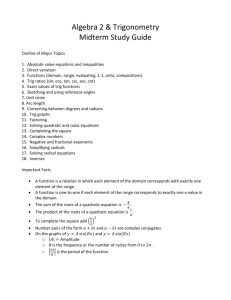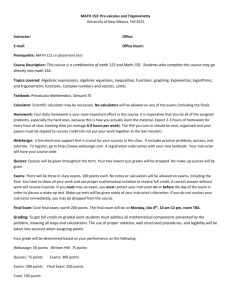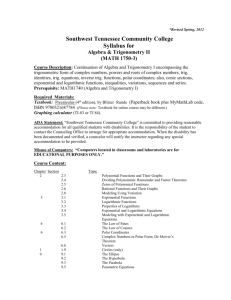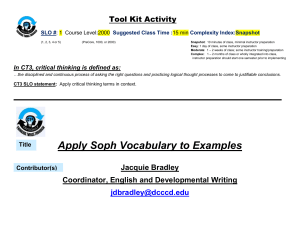MATH 116: Topics In Pre-calculus Mathematics University of New
advertisement
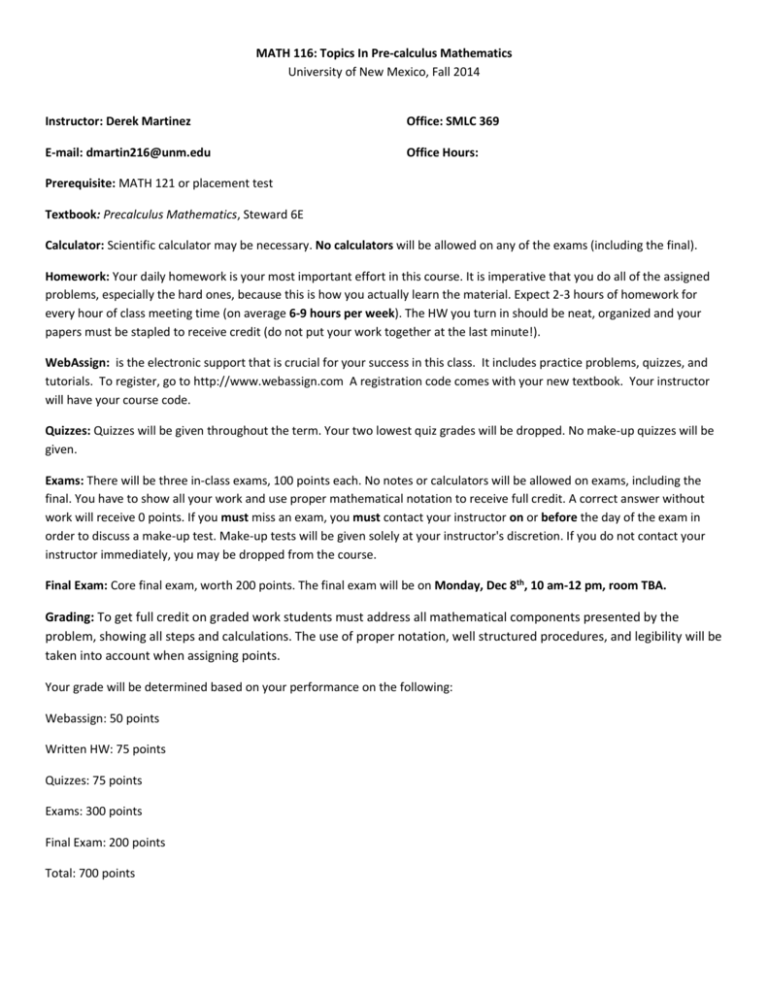
MATH 116: Topics In Pre-calculus Mathematics University of New Mexico, Fall 2014 Instructor: Derek Martinez Office: SMLC 369 E-mail: dmartin216@unm.edu Office Hours: Prerequisite: MATH 121 or placement test Textbook: Precalculus Mathematics, Steward 6E Calculator: Scientific calculator may be necessary. No calculators will be allowed on any of the exams (including the final). Homework: Your daily homework is your most important effort in this course. It is imperative that you do all of the assigned problems, especially the hard ones, because this is how you actually learn the material. Expect 2-3 hours of homework for every hour of class meeting time (on average 6-9 hours per week). The HW you turn in should be neat, organized and your papers must be stapled to receive credit (do not put your work together at the last minute!). WebAssign: is the electronic support that is crucial for your success in this class. It includes practice problems, quizzes, and tutorials. To register, go to http://www.webassign.com A registration code comes with your new textbook. Your instructor will have your course code. Quizzes: Quizzes will be given throughout the term. Your two lowest quiz grades will be dropped. No make-up quizzes will be given. Exams: There will be three in-class exams, 100 points each. No notes or calculators will be allowed on exams, including the final. You have to show all your work and use proper mathematical notation to receive full credit. A correct answer without work will receive 0 points. If you must miss an exam, you must contact your instructor on or before the day of the exam in order to discuss a make-up test. Make-up tests will be given solely at your instructor's discretion. If you do not contact your instructor immediately, you may be dropped from the course. Final Exam: Core final exam, worth 200 points. The final exam will be on Monday, Dec 8th, 10 am-12 pm, room TBA. Grading: To get full credit on graded work students must address all mathematical components presented by the problem, showing all steps and calculations. The use of proper notation, well structured procedures, and legibility will be taken into account when assigning points. Your grade will be determined based on your performance on the following: Webassign: 50 points Written HW: 75 points Quizzes: 75 points Exams: 300 points Final Exam: 200 points Total: 700 points Attendance: Attendance is mandatory. If a student has more than three unexcused absences he/she may be dropped from the course. Tardiness or early departure may be regarded as absence. Please note that it is the student’s responsibility to drop the course if he/she stops attending. A failing grade of “F” may be assigned if the student stops attending and does not drop. Student Behavior: According to the Code of Conduct as stated in the Policies and Regulations for UNM, student activities that interfere with the rights of others to pursue their education or to conduct their University duties and responsibilities will lead to disciplinary action. This includes any activities that are disruptive to the class and any acts of academic dishonesty. Students are expected to behave in a courteous and respectful manner toward the instructor and their fellow students. Students may be dropped for inappropriate behavior. The use of cell phones, headphones, etc. is not permitted during class or exams. Cheating: Cheating of any kind will not be tolerated. Examples are: looking at a neighbor’s exam, plagiarizing, using a calculator when not permitted, using the book and/or a cheat sheet, modifying an exam after it is graded, etc. The instructor may warn an offending student, the score of the exam may be reduced, the score may be set to zero, the student may get dropped from the class, the student may get a grade of F for the class, and in most cases the incident will be reported to the Dean of Students. Deadlines: The Department of Mathematics and Statistics will adhere to all of the registration deadlines published by the Office of the Registrar in the schedule of classes. Grading: To get full credit on graded work students must address all mathematical components presented by the problem, showing all steps and calculations. The use of proper notation, well structured procedures, and legibility will be taken into account when assigning points. Students who withdraw after the end of week 3 will receive a grade of “W”. If you do not withdraw, you will receive a letter grade of A, B, C, D, or F (but not a W). See the syllabus for all deadlines. Accessibility Statement: We will accommodate students with documented disabilities. During the first two weeks of the semester, those students should inform the instructor of their particular needs. Extra Help: In addition to your instructor's office hours, there is extra help available at: - The Algebra Tutoring Table, staffed by algebra instructors 9 - 3 every day. It is located in front of the elevators on the second floor of DSH and behind room #224. - CAPS: Center for Academic Program Support. Located on the 3rd floor of Zimmerman Library, 277-4560 - MEP Engineering Annex, room 210, or call the study group at 277-8795 - CATS: Counseling and Therapy Services, Student Health Center, 277-4537. (For test anxiety, etc.) Registration, Drop, and Grade Change Deadlines: The Department of Mathematics and Statistics will adhere to ALL registration deadlines published by the Office of the Registrar in the schedule of classes. For full term classes in the fall 2014 term the deadlines are: August 29th September 5th September 12th November 7th December 5th Add a course, change sections, or change grade mode in loboweb Last day to drop without a grade Last day to change grading option in person Last day to withdraw without the Dean’s permission (grade of W assigned) Last day to withdraw with the Dean’s Permission Math 123-150: Trigonometry and Precalculus Student Learning Outcomes By the end of the semester, students should be able to (SLO#1) Use Correct Mathematical Notation and Terminology (SLO#2) Graph and Interpret Functions: Sketch and interpret graphs in context of applications; apply appropriate transformations for the following: polynomial functions (linear, quadratic, followed by those with degree three and higher), trigonometric functions, exponential and logarithmic functions, rational functions, parametric equations, and conic sections. Be able to create and graph piece-wise functions from all of the above. Create graphs to model situations. (SLO#3) Perform Operations on Functions: Be able to use function notation to evaluate expressions and perform operations on functions such as addition, subtraction, multiplication, division, composition and difference quotients of functions. Be able to find the domain and range of functions as well as their inverses (if they exist). (SLO#4) Analyze the Behavior of Functions: Be able to determine the end behavior and intercepts of functions. Be able to determine extreme values of functions and intervals where functions increase or decrease. Apply this analysis to interpreting an applied problem. (SLO#5) Solve Equations: Be able to solve exponential, logarithmic, trigonometric, quadratic, radical, and rational equations. Also be able to solve linear and non-linear systems of equations. Be able to interpret solutions in context of applications. (SLO#6) Solve Applied Problems: Be able to set up models from word problems using appropriate functions or laws. (SLO#7) Perform Operations with Complex Numbers and Vectors: Be able to determine the trigonometric and polar form of a complex number. Be able to add vectors in two dimensions, project vectors onto one another, and determine the angles between vectors. Use vectors and complex numbers to solve applied problems. Note: The instructor reserves the right to change the syllabus at any point of time during the semester. Tentative Schedule Week 1 Week of 8/18 Monday 1.7 Inequalities 2 8/25 2.6 Combining Functions 3 9/1 No Class 4 9/8 Exam 1 5 9/15 4.3 Logarithmic Functions 6 9/22 10.8 Non-linear Systems 7 8 9/29 10/6 9 10/13 10 10/20 11 10/27 12 11/3 13 11/10 14 15 16 17 11/17 11/24 12/1 12/8 Review 6.2 Trig of Acute Angles/Applications 6.4 Inverse Trig Functions and Right Triangles 5.2 Trig Functions of Real Numbers 7.1 Basic Trig Identities 7.5 More Trig Equations 8.4 Parametric Equations 9.1 Vectors in 2D 13.2 Limits Review for Final Exam Wednesday 2.2 Graphs of Functions/2.4 Average Rates of Change 3.1 Quadratic Functions and Models 3.7 Rational Functions 2.7 Inverse Functions 4.4 Laws of Logs/4.5 Exponential Equations 11.1/11.2 Parabolas and Ellipses Exam 2 6.3 Trig Functions of Angles 6.5/6.6 Law of Sines and Cosines Friday 2.5 Transformations 3.2 Polynomial Functions Review 4.1,4.2 Exponential Functions 4.6 Exponential and Log Models 11.3 Hyperbolas 6.1 Angle Measure Holiday 5.1 Unit Circle 5.3 ,5.4 Trig Graphs 7.2, 7.3 Special Formulas Review 5.5 Inverse Trig Functions 7.4 Trig Equations 8.1 Polar Coordinates 9.1, 13.1 Limits 13.4 Limits Cumulative Monday Dec 8th 8.3 Polar Form of Complex Numbers 13.1 Limits Holiday Final 10am-12pm Exam 3

